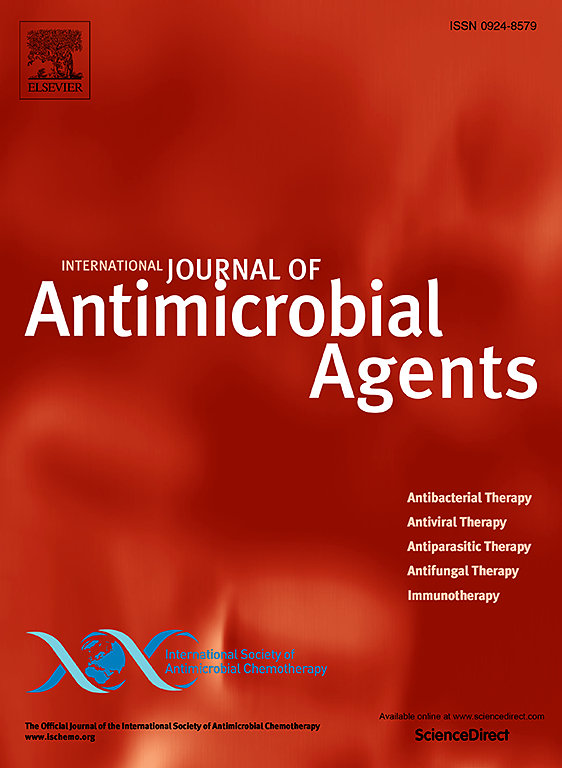Cellular and genetic changes during and after fluconazole exposure in Cryptococcus neoformans
IF 4.6
2区 医学
Q1 INFECTIOUS DISEASES
International Journal of Antimicrobial Agents
Pub Date : 2025-04-17
DOI:10.1016/j.ijantimicag.2025.107519
引用次数: 0
Abstract
The validity of genome replication is fundamental to fungal survival, and errors in this process can result in ploidy changes. These changes can have negative effects, such as developmental defects or reduced fitness, or positive effects such as fungal adaptation and resilience. In the fungal pathogen Cryptococcus neoformans, ploidy changes have been consistently observed in clinical populations, and isolates exposed to the antifungal drug fluconazole commonly exhibit chromosome 1 aneuploidy. Chromosomal and putative metabolic function changes due to drug exposure are not well studied and are important for understanding resistance. Objectives: This study examined the fluconazole influence on C. neoformans transient aneuploidy and identified any potential genetic pathways that may be implicated. Methods: The study investigated 30 genes predicted to have a role in transient aneuploidy, which are related to chromosome organisation, DNA damage checkpoints and stress signalling. Other factors including ploidy status (haploid, diploid, polyploid) and species were also investigated to observe commonalities for a universal drug treatment strategy. Results: Fluconazole treatment increased DNA content, cell size and chromosomal changes in the wildtype and mutants. When fluconazole was removed, permanent changes were observed and were highly variable in the wildtypes and the 30 mutants. Additionally, some mutants lacked chromosomal changes such as tel1∆, mrc1∆ and hog1∆, highlighting the potential involvement in the aneuploidy process. Conclusions: These findings highlight that fluconazole influences the entire genome rather than specific chromosomes, which increases the heterogeneity in permanent changes after fluconazole removal. This heterogeneity may result in long–term consequences, including drug resistance.

新型隐球菌在氟康唑暴露期间和之后的细胞和遗传变化
基因组复制的有效性是真菌存活的基础,在这一过程中的错误可能导致倍性变化。这些变化可能产生负面影响,如发育缺陷或适应性降低,也可能产生积极影响,如真菌的适应和恢复能力。在真菌病原体新型隐球菌中,在临床人群中一致观察到倍性变化,暴露于抗真菌药物氟康唑的分离株通常表现为1号染色体非整倍性。由于药物暴露导致的染色体和假定的代谢功能变化尚未得到很好的研究,这对了解耐药性很重要。目的:本研究探讨氟康唑对新生C.瞬时非整倍体的影响,并确定可能涉及的任何潜在遗传途径。方法:研究了30个与染色体组织、DNA损伤检查点和应激信号有关的基因,这些基因被预测在瞬时非整倍体中起作用。其他因素包括倍性状态(单倍体、二倍体、多倍体)和物种也进行了调查,以观察通用药物治疗策略的共性。结果:氟康唑处理增加了野生型和突变体的DNA含量、细胞大小和染色体变化。当氟康唑被去除时,观察到永久性的变化,并且在野生型和30个突变体中高度可变。此外,一些突变体缺乏染色体变化,如tel1∆,mrc1∆和hog1∆,突出了非整倍体过程的潜在参与。结论:这些发现强调氟康唑影响整个基因组而不是特定染色体,这增加了氟康唑去除后永久性变化的异质性。这种异质性可能导致长期后果,包括耐药性。
本文章由计算机程序翻译,如有差异,请以英文原文为准。
求助全文
约1分钟内获得全文
求助全文
来源期刊
CiteScore
21.60
自引率
0.90%
发文量
176
审稿时长
36 days
期刊介绍:
The International Journal of Antimicrobial Agents is a peer-reviewed publication offering comprehensive and current reference information on the physical, pharmacological, in vitro, and clinical properties of individual antimicrobial agents, covering antiviral, antiparasitic, antibacterial, and antifungal agents. The journal not only communicates new trends and developments through authoritative review articles but also addresses the critical issue of antimicrobial resistance, both in hospital and community settings. Published content includes solicited reviews by leading experts and high-quality original research papers in the specified fields.

 求助内容:
求助内容: 应助结果提醒方式:
应助结果提醒方式:


